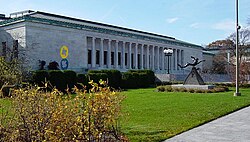The Toledo Museum of Art is an internationally known art museum located in the Old West End neighborhood of Toledo, Ohio, United States. It houses a collection of more than 30,000 objects. The museum was founded by Toledo glassmaker Edward Drummond Libbey in 1901, and moved to its current location, a Greek revival building designed by Edward B. Green and Harry W. Wachter in 1912. The building was expanded twice in the 1920s and 1930s. As of May 2014, Brian Kennedy serves as the museum's ninth director.
Exhibits

The museum contains major collections of glass art of the 19th and 20th century, European and American art, as well as small but distinguished Renaissance, Greek and Roman, and Japanese collections. Notable individual works include Peter Paul Rubens's The Crowning of Saint Catherine, significant minor works by Rembrandt and El Greco, and modern works by Willem de Kooning, Henry Moore, and Sol LeWitt, as well as Fragonard's Blind Man's Bluff.
A concert hall within the east wing, the Peristyle, is built in a classical style to match the museum's exterior. The hall is the principal concert space for the Toledo Symphony Orchestra. A sculpture garden, containing primarily postwar works (earlier sculptures are on display in the interior) was added in 2001, and runs in a narrow band along the museum's Monroe Street facade.
The Rubens painting, The Crowning of Saint Catherine, was bought by the Toledo Museum of Art from Albert Koppel in 1950. Rubens had originally painted it for the church of the Augustinians in Mechelen (Malines) where it was installed in 1631. In the eighteenth century the church authorities sold it to a dealer and in 1779 it was purchased by the 5th Duke of Rutland. It remained as part of the Rutland estate until 1911 when the 8th Duke of Rutland sold it to the German-Jewish banker and science entrepreneur Leopold Koppel. On Koppel’s death in 1933 it was illegally appropriated by senior Nazi Hermann Göring for his private collection. At the end of World War II it was discovered by American troops in a salt mine and was eventually reclaimed, with several other paintings, by Albert Koppel, Leopold's son.
Glass Pavilion

A Center for the Visual Arts, designed by Frank Gehry, was added in the 1990s. It includes the museum's library as well as studio, office, and classroom space for the art department of the University of Toledo. In 2000, the architectural firm of SANAA was chosen to design a new building, to house the museum's glass collection; it was the firm's first commission in the United States. Front Inc. was appointed to assist the architects in developing technical concepts for the glass wall systems. The Glass Pavilion opened in August 2006 to considerable critical acclaim; in his review for The New York Times, Nicolai Ouroussoff said, "Composed with exquisite delicacy, the pavilion’s elegant maze of curved glass walls represents the latest monument to evolve in a chain extending back to the Hall of Mirrors at Versailles." Ouroussoff commented on the Pavilion's relationship with the Museum's other buildings:
The Glass Pavilion is part of a loosely knit complex that includes the Beaux-Arts-style art museum here and the University of Toledo’s Center for the Visual Arts, designed by Frank Gehry. With its grand staircase leading up to a row of Ionic columns, the original museum is both a temple to art and a monument to the belief in high culture’s ability to uplift the life of the worker. The new structure’s low, horizontal form, fits in this context with remarkable delicacy, as if the architects hesitated to disturb the surroundings.
The building's curved glass walls were imported entirely from China. The building showcases the museum's original glass collection in addition to several new works, including one prominent glass sculpture by Dale Chihuly. The Glass Pavilion is made possible through the largest public fundraising drive in Toledo's history.
Peristyle

The 1,750-seat Peristyle concert hall was part of the 1933 expansion. It is the permanent home of the Toledo Symphony Orchestra and hosts the Museum's Masters series. Seating at the Peristyle is divided into floor and riser seating, with the riser seating arranged in a half-circle, similar to a Greek theater. At the back of the riser seating are 28 Ionic columns that give the concert hall its name.
See also

- Houses at Auvers
References
Notes
Resources
- Ouroussoff, Nicolai. "A Crystal Showcase Reflects a City’s Glass Legacy." The New York Times, August 28, 2006.
- Davis, Ben. "Glass Houses" Artnet Magazine, Aug. 30, 2006.
External links
- Official museum webpage
- Center for Visual Arts, University of Toledo
- Video review of the Museum with on-site footage
Posting Komentar